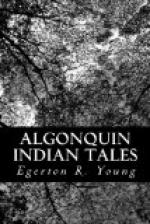“Now that I know why it is that the prickles are on the wild roses I’ll not get mad even if my fingers bleed when I am gathering a bouquet for mother.”
At this moment the two favorite dogs, Jack and Cuffy, came bounding up. By this the children knew that their father was not far behind, and they were not disappointed. At first he looked anxious when he saw the little hands wrapped up in green leaves, but as with merry laughs they told him what the leaves were for everything was bright again.
Souwanas was greeted very cordially, as usual, and assured that at the mission house he would find in the mistress a willing purchaser of his ducks and rabbits. The children were always interested in the game, although Minnehaha strongly declared that it was a pity to kill the pretty creatures. Souwanas and their father were chatting together while the children were turning the ducks and rabbits over.
“See what red eyes some of the ducks have,” said Sagastao. “They look as though they had been crying.”
“Guess you would have cried too,” rather indignantly replied Minnehaha, “if you had been shot as they were.”
“Huh!” he replied with a tinge of contempt, “how could they cry after being shot? I don’t believe that is it at all. And, look here, Minnehaha, I am going also to ask why it is that, while all the rabbits were so white in winter, they are all now so brown in summer.”
Quickly the resolve was carried out, and so, while Minnehaha was telling her father what a beautiful story they had heard about the roses, Sagastao, with his hand on the shoulder of the old Indian, who was seated on a rock, was eagerly firing at him his double-barreled question: “Why have some ducks such red eyes, and why are the rabbits white in winter and brown in summer?”
“Both done by Nanahboozhoo,” said the old man with a smile, as he took his pipe out of his mouth.
“Hurrah for Nanahboozhoo!” shouted the lad.
This outburst on the part of Sagastao at once attracted the attention of the others to him and Minnehaha wanted to know what was the matter now.
“Why, did you not hear? Souwanas says that Nanahboozhoo gave the ducks the red eyes and makes the rabbits to be white in winter and brown in summer.” Then turning to Souwanas he asked, “How does Nanahboozhoo do it?”
Here the father, while amused at the lad’s enthusiasm, interposed, and said:
“You have already kept Souwanas a long time, and perhaps he is busy.”
“Busy!” said the irrepressible Sagastao, who was shrewd beyond his years. “Busy! Why Souwanas would rather tell stories than do anything else—unless to smoke his pipe.”
Then he glibly told Souwanas in Saulteaux what had passed between him and his father in English, and added, “Is that not so, Souwanas?”
The old Indian smiled, and said kindly:
“How can I help enjoying telling stories when I have such good little listeners?”




